Cossacks and the First World War. Part II, 1914 year
The global catastrophe began with the fact that 28 July 1914, Austria-Hungary declared war on Serbia. On the same day, on the orders of the high command of the Russian imperial army, the 2-I Cossack Division moved to the Austrian border. It consisted of the Don, Terek and Kuban Cossacks and in peacetime was located on the right bank of the Dnieper in the territory of modern Vinnitsa and Khmelnitsky regions of Ukraine. Tsar Nicholas II was still hoping to come to an agreement with the German Kaiser and the troops stood motionless on the German border. And the movement of troops to the Austrian border and partial mobilization Russia began allegedly in order to put pressure on Austria-Hungary. Therefore, the Cossack cavalry, located in Ukraine, became the first part of the Russian army, which left the barracks and fought on the still undeclared war. The consolidated Cossack division was supposed to cover the mobilization and concentration of General Brusilov’s 8 Army, which took several weeks to receive reinforcements and reinforcements from the internal provinces of Russia. And in the first week of August 1914, the front line was the border river Zbruch, a tributary of the Dniester, which divided the possessions of the Austrian and Russian empires in Ukraine. The Cossacks prevented the Austrian equestrian reconnaissance from crossing the river, and they themselves tried to cross Zbruch in order to reconnoiter the situation on the territory of the enemy. After several skirmishes, the Cossacks suffered their first losses in the morning of August 4 1914, when two privates of the Kuban Cossack Army 1 Line Regiment were seriously injured. In fact, these were the first Russian casualties of the Great War of 1914-18. At the same time officially Russia and Austria-Hungary were not yet at war. The representative of Vienna in St. Petersburg, Count Friedrich Sapari, half German, half Hungarian, will present a note on the announcement of hostilities two days later. In the early days of the conflict on the Austrian front, the Don, Terek and Kuban Cossacks from the 2 Consolidated Cossack Division were opposed by four hussar regiments of the Austro-Hungarian Cavalry Division, consisting mainly of Hungarians. On August 4 they crossed the border and the Cossacks were attacked by the real hussars, embroidered with twisted cords of multi-colored “dolmano” jackets familiar to every reader from the 1812 image of the year. The uniform was complemented by krapovo-red, bright cavalry jodhpurs, “chikchirs”. Hungarians hussars french was called "Attila" - the term "hussars" itself, goes back to the Hungarian Huszar, denoting light steppe cavalry, and the jackets embroidered with cords really go back to the era of the Great Migration of the People and the Huns of Attila, the legendary ancestors of the Ugric Hungarians. In the Great War, the Cossacks first met the enemy and won her first victory. General Krasnov P. N. wrote later: “The Hungarian cavalry struck with its valor in equestrian attacks. She went on machine guns in closed formations ... Then she took on the attack of mounted hundreds of horses ... With the art and extraordinary courage of linear officers and Cossacks she was defeated, overthrown and brought to panic ... and completely devastated by Satan at night. " A little later 21 in August near the village of Yaroslavlitsa (30 km west of Ternopil) the 10 Cavalry Division under the command of Count F.A. In the famous equestrian equestrian battle, Keller defeated the “White Dragoons” of the 4 Cavalry Division that were considered the best in the Austro-Hungarian army, outnumbering the Kellers. The fate of the battle was decided by Fedor Arturovich himself - “the first piece of Russia”. With the command "headquarters and convoy to attack me," he rushed to the counterattack and crumpled the Austrians breaking through to the rear.
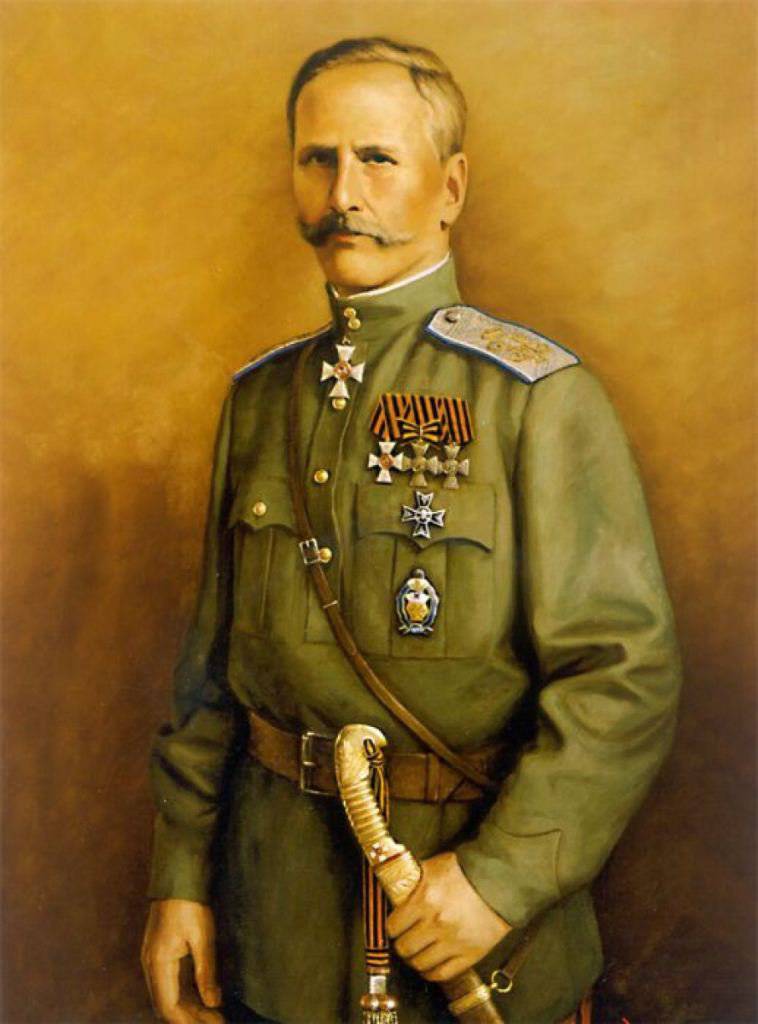
Rice 1. Count F.A. Keller - “the first piece of Russia”
Especially distinguished hundreds of 1-th Orenburg Cossack regiment, who broke through to the rear of the enemy, cut off his escape route across the river and completed the rout. The 3 th Don Cossack artillery division also distinguished itself in battle. These victories inspired our cavalry. After all, Napoleon said: "... the outcome of the battles by three quarters determines the spirit of the troops, and only by a quarter - the balance of power." All distinguished themselves in battle were awarded.
Rice 2. Presentation of awards Kellerites (OKV, 1-y regiment)
However, these victories were achieved as a result of successful counterattacks on mindlessly (if not to say crazy) attacking enemy. At the same time, the first clashes in the frontier zone showed that with modern military equipment and fire weapons, deep raids into the rear and a breakthrough of the front of the protivnik are difficult to accomplish, and the tasks assigned by the operational plans to the cavalry, in most cases, are beyond its power.
On August 2, early in the morning, in all parts of the Russian army, a telegram was received announcing the war against Germany in Russia, which served as the beginning of hostilities on the German front. By the beginning of the war, it was not exactly known about the final decision of the German General Staff, in which direction the main attack would be directed — at Russia or France. This decision was important, since the activities of the Allied army depended on it and the course of operations was determined. The Germans held the initiative in their hands. In full accordance with the Schlieffen plan, the German army, on the Western front, launched a decisive offensive, and moved right flank to Liege, thereby violating Belgium’s neutrality. Germany’s violation of Belgium’s neutrality guaranteed by England put the latter in a position to defend it. England 4 August declared war on Germany and opposed it on the side of the Allies - the conflict quickly became global.
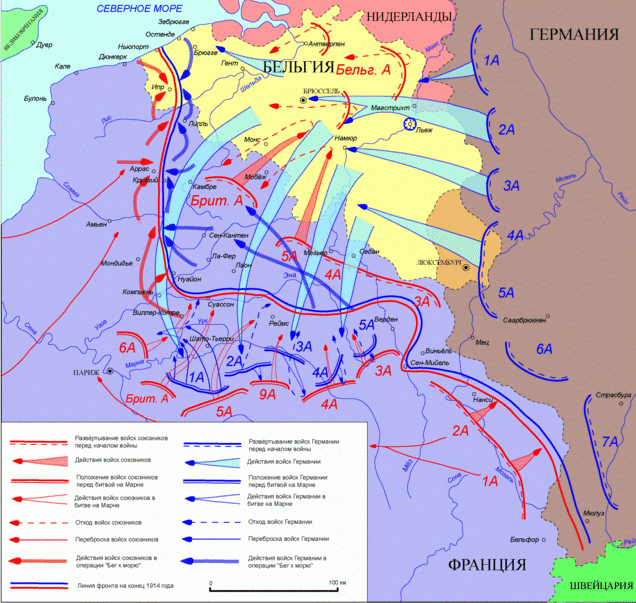
Fig. 3 Western Front, 1914 Year
It should be said that with the general equality of the pre-war mistakes and miscalculations by the military-political leadership of the countries of the Entente blocs and the Triple Alliance, there were also nuances that allowed Germany to have some military advantage at the beginning of the war. One of the main was the superiority of the Reichswehr in heavy artillery. By the beginning of the war, Germany had 1688 heavy field artillery guns, Austria-Hungary - 168, Russia - 240, Great Britain - 126, France - 84. This was due to the fact that the German command always proceeded from the fact that they would have to break through powerful lines of border fortresses and fortified areas, for which there were connections of powerful and super-power long-range and siege artillery. However, at the very beginning of the war, another worthy use was found for this artillery, the counter-battery struggle. Especially catastrophic situation has developed on the Franco-German front. By the number of heavy guns Germans surpassed the French by a hundred times. The German army, using the advantage of long-range guns of large caliber, with impunity destroyed at great distances light field artillery of the French and inflicted heavy casualties to manpower. With the help of intelligence information from airplanes and aerostats, German heavy artillery quickly led to silence all the light field artillery of the French.
Fig. 4 German heavy artillery in positions
Infantry units were left without artillery fire support and allied forces were shot with impunity by German artillery. The French armies on the whole front, suffering heavy losses from enemy artillery fire, retreated. There was a rupture between the army of Belgium and the left flank of the 5 Army of the French, and their retreat went in different directions. But since in all the failures of the higher authorities usually find the winners of the subordinates, the French commander-in-chief Joffre, with the consent of the Minister of War Messim, began to make a merciless cleansing of the highest command. In the army, brutal discipline was introduced, accompanied by demands to hold positions, regardless of losses. The retreating Allied armies retreated to the line of the River Marne, in 40 km from Paris. 2 September the French government fled to Bordeaux. But having reached the line of the River Marne, the German command of the reserves did not have, they went east to rescue East Prussia. On the Marne began hard battles. At this time, the commander of the defense of Paris, General Galeni, with a quick transfer of the 6 Army from the side of Paris brought her to the right flank of the advancing Germanic front and decided the fate of the battle. The frontal attacks of the German armies were restrained by the great efforts of the French armies, but when the army appeared on the flank, General von Moltke did not manifest the qualities of his uncle, the elder Moltke, and did not fulfill General von Schlieffen’s covenant to strengthen the right flank, but ordered the armies to retreat. September 10 began a general retreat of the German armies along the whole front. At the same time, the Belgian army retreated to Antwerp, and the Belgian government, in order to defend itself, opened the floodgates at high tide and flooded a large part of the country with water. The offensive of the German army was stopped. In the German Army, the High Command belonged to the Kaiser, and the actual Commander-in-Chief was the Chief of the General Staff. At the beginning of the war he was General von Moltke. For failures, he was removed, and General von Falkenhayn was appointed to his place.
Under an agreement with the French General Headquarters, Russia, if Germany would send the main blow to France, pledged to begin the onset of its troops on Austria and East Prussia in order to facilitate the situation on the French front in every possible way. At the same time, the choice of the direction of the main attack in the East was kept by the Russian command, and it set the main goal of the offensive against Austria. The 18 (6) of August began the Battle of Galicia - a huge-scale battle between the Russian forces of the South-Western Front under the command of General Ivanov and the Austro-Hungarian armies under the command of Archduke Frederick. Four Russian armies were deployed against Austria: 3, 4, 5, 8, and another 9 was formed during the operation. A powerful grouping of Cossack units was concentrated at the beginning of the operation in the South-Western Front, and during the operation, echelons with 3, 4 and 5 from the Don Cossack divisions approached. The total number of Cossack units at the front exceeded 20 thousand people. Four Austrian armies and one army group were deployed against the Russian armies of the South-Western Front. Russian troops launched an offensive on a broad (450 — 500 km) front, having the Lemberg center (Lviv). The military operations of the armies that took place on a long front were divided into numerous independent operations, accompanied by both attacks and retreats from both sides. The plan of the Russian command on the environment of the Austrian army was built on the wrong information, obtained by intelligence, about the deployment of the Austrian army to the east and north of the river San. In fact, the deployment of the Austrian army was carried out to the west of this river. Attacking from the north in the direction of Przemysl, units of the 4 of the Russian army were dangerously placed under a flank attack from the west. In the course of the attack, the 19 army corps of the 5 Army, which had fallen into complete encirclement, was in an especially difficult situation. But the equestrian attack of 1 and 5 of the Don Cossack divisions to the rear of the Austrian corps 11 of the Austrians were rejected, and the corps left the encirclement. At the same time, the 3-I and 8-I Russian armies successfully launched an offensive from the Dubno-Proskurov line in a south-western direction to the Lviv-Galich front and 20. August 3-th army occupied Lviv, Galich and Nikolaev. At the same time, the 4-I and 5-I armies, under pressure from the enemy, retreated to their original position. Russian command has made a regrouping of troops. Until September 12, the Austro-Hungarians did not cease desperate attempts to recapture Lviv, fierce battles went 30-50 km to the west and north-west of the city, but ended in complete victory for the Russian army. Since September 12, a general retreat of the Austrian army began, more resembling flight. The Russian army in a short time captured a huge, strategically important territory - Eastern Galicia and part of Bukovina. By September 26, the front stabilized at a distance of 120 — 150 km west of Lviv. The strong Austrian fortress of Przemysl was under siege in the rear of the Russian army. In the battle for Galicia, the Austrian troops were defeated. Thus, the plans of the German command to quickly destroy the forces of the pro¬tivnik on the Western Front and to keep the Eastern Front by the forces of the Austro-Hungarian army failed.
The worst border battles for the 1 and 2 Russian armies on the front of East Prussia had much worse consequences. The difficult situation of the French army and the threat of its complete defeat demanded from the Russian command immediate and energetic help, the transition of the armies on the Eastern Front against Germany. The offensive began when the armies had not yet received the replenishment of the second-priority divisions and were not transferred in composition to the states of military time. Despite this, the Russian armies had a numerical advantage, and in cavalry it was overwhelming. By the time the North-Western Front launched an offensive, it included about 20 Cossack regiments and 16 individual hundreds of a total of over 20 thousand people. Already in the first battles, the predominant importance of heavy artillery in the field troops of the German army, which produced not only a strong moral effect, but also great losses, was determined. It also revealed the need to ensure reliable communication between military units, which was not in the Russian army. In the initial, as well as subsequent, operations of the Russian troops in Prussia, it was characteristic that with the presence of a large number and the best in quality Russian cavalry there was absolutely no connection between the parts. The cavalry did not know what was happening on the front of the main forces, the flanks of which it provided, and in the army there was no knowledge of the activities of the cavalry. Nevertheless, with the powerful pressure of the Russian troops of the 1 Army, the victory was won at Gumbinnen. When taking Gumbinnen (now Gusev of the Kaliningrad region) was especially distinguished by the 39-th Don Cossack regiment, which attacked German troops defending the city on the dispersed hundreds at night. Unable to withstand the attack, the enemy garrison retreated across the River Angerepp. The Cossacks were also the first to enter Goldap, Aris, Elk, Bishofshteyn. The 3-th Don Cossack regiment successfully operated in the cavalry group of Khan Nakhichevansky, and the 51-th Don Cossack regiment 17 of August 1914 of the year occupied the historically memorable for Russia Tilzit (now Sovetsk Kaliningrad region). The 47 th and 48 th Don Cossack regiments showed their military training under Preuss-Eylau (now Bagrationovsk, Kaliningrad region), Friedland, that is, in those memorable places where their forefathers fought bravely with Napoleon's troops more than a hundred years ago. On the left flank of the 1 Army, the 1 Don Cossack Regiment bravely fought, especially distinguished itself in the raid on the city of Allenstein in mid-August. A terrible panic arose at the 8 headquarters of the German army, and commander General von Pritvitz decided to leave East Prussia, withdraw beyond the Vistula, and began evacuating troops to the west by rail. Moreover, the Germans in the reports to their General Staff even feared that the water level in the river was low and would not stop the Russians. In Prussia, a terrible alarm set in. He was even more aggravated by the refugees, who spread panic rumors about wild Cossacks, "pushing German babies and raping women on their peaks." Schlieffen’s plan, however, allowed for the possibility of a defeat on the Eastern front and the departure of the barrier deep into the German Empire. It was believed that in this case it was by no means impossible to withdraw divisions from the Western Front in order to guarantee defeat of the French army and avoid war on two fronts. However, the decision of Pritvits was not accepted in Berlin, where they were afraid of the political and moral consequences of the loss of East Prussia. Königsberg was considered the second most important city of the Second Reich. The city was considered the heart of the German Empire, the site of the coronation of the Prussian kings. East Prussia was the patrimonial nest of many military and noblemen; Prussian youth dominated the German hierarchy. The German Stavka decided not to turn in East Prussia and to transfer two corps from the Western Front (11 Army and Guards Reserve) and the 8 Cavalry Division. Thus, psychology defeated strategy. This decision saved East Prussia from being captured by Russian troops, but played a fatal role in the battle of Marne. The tactical success of the German army on the Eastern Front due to the transfer of troops from the Western Front resulted in a strategic defeat of Germany in the West. Germany had to wage a long war on two fronts. And in such a war, the resources of the Central Powers strongly lost to the potential of the Entente countries. On August 22, the Chief of General Staff von Moltke dismissed the “alarmist” Pritvits and replaced him with General von Hindenburg called out of retirement, and von Ludendorff became Chief of Staff of the 8 Army. These two generals turned out to be more worthy students of Moltke the Elder. They did not begin to deploy military echelons to the west, but unloaded them in the offensive zone of the 2 of the Russian army. This maneuver was not known to the Russian command and allowed the Germans to create a reserve in the offensive zone of the 2 army. At the same time, two German army corps and a cavalry division were removed from the Belgian front and sent to the Eastern front. In addition, two German reserve corps, formed within the country and intended to be sent to the Western Front, were detained and sent for action on the Eastern Front. As the French General Dupont later wrote: "... from this mistake, the chief of the German General Staff, General von Moltke, another Moltke, his uncle, had to roll over in his grave ...". As a result of this error, a “miracle on the Marne” occurred. And the First Lord of the British Admiralty, U. Churchill, in an article in the Daily Telegraph, wrote: “A Miracle on the Marne,” was won by the Russian Cossacks, ”but this was a pathetic exaggeration.
Fig. 5 Raid Cossacks in the rear in East Prussia
For the sake of justice, it should be said that the failure of the Schlieffen plan to be credited exclusively with the activities of the Russian army, and even more so with the Cossacks, would be a clear exaggeration. The plan began to pop from the very beginning of the war in several important areas, namely:
1. Italy refused to enter the war on the side of the Triple Alliance, and this was an absolutely necessary condition for the success of the entire plan. Firstly, the Italian army, advanced to the border with France, was to divert a significant part of the French troops. Secondly, the Italian fleet, combined with the Austrian, would pose a serious threat to the communications of the Entente in the Mediterranean Sea. This would force the British to hold large forces there. fleet, which ultimately would lead to the loss of her absolute dominance at sea. In reality, however, the German and Austrian fleets were practically blocked in their bases throughout the war.
2. Neutral Belgium had a sudden and stubborn resistance to the Germans. Despite the fact that the Belgian army was only a tenth of the German army, the Belgian soldiers steadfastly held the country's defense for about a month. The Germans used the giant “Big Bert” cannons to destroy the Belgian fortresses in Liege, Namur and Antwerp, but the Belgians stubbornly did not surrender. In addition, the German attack on neutral Belgium led many neutral countries to reconsider their views on Germany and Kaiser Wilhelm.
3. The mobilization of Russia was faster than the Germans had supposed, and the invasion of Russian troops into East Prussia was completely discouraged by the German command. These events forced the command to transfer more troops to the eastern front. But this spraying was counterproductive. After winning the battle of Tannenberg in early September 1914 of the year (defeating the 2 of the Russian army at the Masurian Lakes), the German army no longer won major battles on any front.
4. In connection with some hitch of the Germans in Belgium, France managed to transfer more troops to the borders. The Germans greatly underestimated the ability of the French troops to be deployed, and this led to significant delays in their advancement in France. The French sent troops to the front by any means - even by taxi. At the critical moment of the battle for Paris, 1300 Paris Renault AG-1 taxis were mobilized by General Gallieni and overnight transported more 6000 soldiers from Paris to the banks of the River Marne. By morning, they dug in and closed the gap in the defense. Due to the irrepressible energy of General Galleny for the arrival of the Germans to the borders of Paris, France was already quite ready for military action.
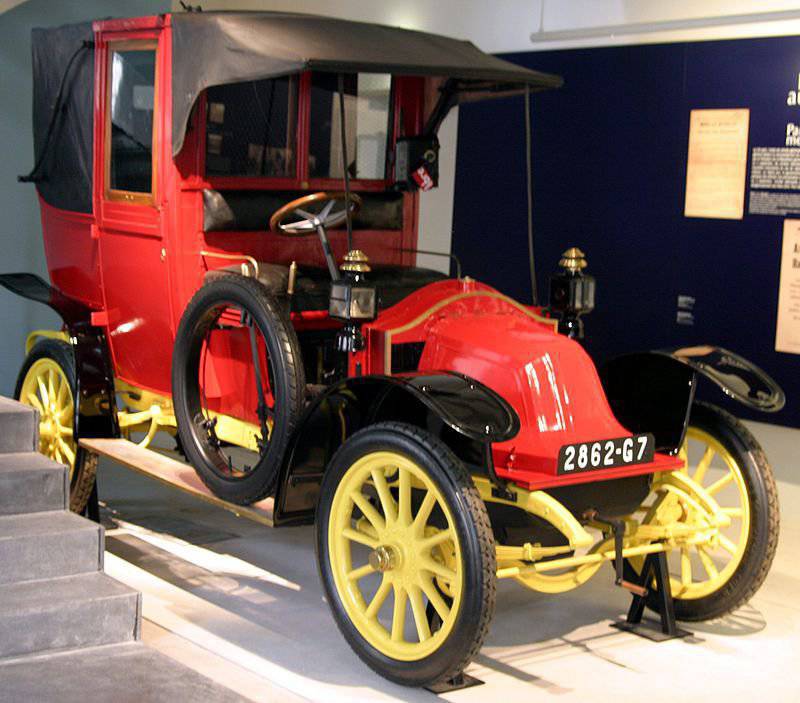
Fig. 6 Marne Taxi
A part of the 2-th Russian army launched an offensive bypassing the Masurian lakes. The ground of most roads in the offensive zone was sandy, difficult for traffic and especially for transport. It was unbearable summer heat. Horses were powerless to pull carts. The troops did not see the wagon train, the daily routine was not given, which weakened the horses and people who had not seen their kitchens for several days. At the headquarters of the 2 Army, there was no news of the enemy’s actual position, the enemy’s resistance was weak, and it seemed as if the army was advancing “into the void”. Rennenkampf did well at the 1 Army, so that the defeated German army did not run away at all over the Vistula, he was ordered to stop at the 2 day, and the 2 army was driven. The commander of the South-Western Front hurried: “German troops, after heavy battles that ended with the victory of General Rennenkampf, hastily escaped, blowing up bridges behind them. Before you the enemy left, apparently, insignificant forces. Therefore, having left one corps at Soldaus and having provided the left flank with a proper ledge, all the other corps themselves vigorously advance. ” However, the position and composition of the 2 of the Russian army at the headquarters of the German command had accurate information found in the bag of the killed officer, and then from the intercepted unencrypted radio programs of the headquarters of the 2. It should be noted that the Germans had a good intelligence situation, good local burghers in various ways reported details about the advancing Russian troops, often just by telephone and telegraph. Knowing the location and exact tasks of the 2 Army Corps, the German command acted with certainty in the distribution of troops. At the same time, telephone communication between the Russian headquarters, due to damage to the wires by the local population, did not function. The 15 and 13 corps are deeply advanced, not having a telephone connection between themselves and the army headquarters. As a result, both corps were bypassed by the Germans and surrounded, the connection between the units was broken, the leadership of the units was lost, and the fighting broke up into separate sections. In addition, the “peaceful German townspeople” still hit the rear of the Russian battalions. The Russian corps was ordered to move south, but it was too late. The surrounding ring was closed by the German troops, and parts of 15 and 13 of the corpus were destroyed or captured. Both corps commanders, Generals Martos and Klyuev, were captured. The German encirclement ring was weak, it was quite possible to pass. The Germans blocked the most important paths with small barriers. However, the generals decided "to avoid unnecessary bloodshed" to surrender. 6, 21 and 40 Don Cossack regiments were also surrounded. The commander of the 40 regiment refused to comply with the order of the commander of the 13 corps of surrender and, together with the infantry regiments, the Cossacks broke through the ring of German troops from Walendorf, but suffered very heavy losses. During the breakthrough, the regiment lost the brave commander, 20 officers and half of the personnel, but he made his way to his own and led a large number of infantry behind him. Podjesaul Pushkarev and the regimental denominator, the senior commander of Arzhenovskov, managed to save the regimental banner and carry it on themselves. The 6 th Don Cossack regiment under the command of Colonel A.N. Isaev utterly defeated the Germans from the cordon ring in the woods near the town of Villenberg and captured the ferry near the village of Horzhele. This made it possible to get out of the environment of most of the 23 army corps. From the location of the 15 corps with heavy fighting, only 4 officers and 312 Cossacks of the 21 Don Cossack Regiment managed to get through. The constable of this regiment, Solovyov, was taken prisoner by the wounded, but managed to save the regimental flag. From captivity, he managed to convey news of the location of the banner. The Cossacks, less often than all others, even the Guardsmen, surrendered, and who were captured by the Germans, could not long tolerate such a fate. There is a lot of documentary evidence about the daring shoots of Cossacks from captivity. In this regard, in November 1916, a special resolution of the Military Council was adopted, according to which all the lower ranks who had escaped from captivity, after careful inspection, were sent to Petrograd, where they were solemnly awarded St. George medals "For a Bold Escape". Moreover, the Cossacks were personally awarded by the emperor, and the rest of the head of the General Staff. Altogether, at the Masurian Lakes, only 170 officers and 10 300 people were able to break through and get out of the encirclement. The army commander, General Samsonov, seeing the death of the army and his conceited illusions, rightly fearing possible captivity and cruel squabbles in the Stavka and the Emperor, shot himself. Meanwhile, the Russian high command before the corps commanders, inclusive, was aware of the game of the German General Staff in 1912 and the decision to conduct the encirclement of the Russian army advancing from Warsaw-Mława. In 1914, the Germans carried out virtually the same plan against the 2 Army, defeating its flanking units and the environment in forest swamps. Despite the availability of this information, not a single supreme headquarters of the Russian command, or even the commander of the 2 Army, General Samsonov, had a thought about the actual plan of the opponent. While the 1-I Russian army was heading into the empty space, having the seductive goal of direct movement to Königsberg, the 2-I army pushed for rapid movement, geographically excluding the possibility of large armed forces. Climbing into the swamps, the units of the 2-th army themselves facilitated the destruction of the German army. The difficult situation on the front of the 2 army was soon so obvious that the commander-in-chief of the Southwestern Front sent a telegram to the headquarters of the 1 Army saying that “the units that had not been seen before you were transported by train to the front 2 th army and stubbornly attacked at Bischofsdorf, Hohenstein and Soldau. Allenstein is occupied by the Germans. The German command, having finished with the units of the 2 Army, decided in a similar way to destroy the corps of the 1 Army. By this time, the corps from the Western Front had already arrived at the Germans on the Eastern Front and entered into business. They sent a blow to the left flank and the rear of the 1 Army. At the first sign of the Germans ’attack on the flank and rear of his army, the commander of the army Geeneral Rennenkampf realized the Germans’ intention and, using reinforced transitions, brought the 20 corps to the area of the threatened breakthrough and, parrying the Germans’s attacks, saved their army from the army’s general Samsonov. As a result of these failures, the commander of the North-Western Front, General Zhilinsky, was removed, and General Ruzsky, who previously commanded the 3 Army in Galicia, was appointed to replace him. On September 4, he ordered the 1 of the Russian army to withdraw beyond the Neman. It should also be said that the Supreme Russian command, having learned that the border with Poland in the Berlin direction was protected only by one landwehr corps, in parallel with the attack in Galicia and East Prussia decided to prepare one more strike in the direction of Berlin. The North-Western and South-Western fronts were to attack on the flanks, linking German and Austro-Hungarian troops, and in the Warsaw area decided to create another strike force that would threaten Berlin. As a result of this decision, the troops that were supposed to reinforce the 1 and 2 army, began to send to Warsaw to form a new 10 army. Because of this, the strike force and reserves of the armies of Rennenkampf and Samsonov were weakened. At the same time, judging by the way the East Prussian operation prepared and developed in August 1914, it is impossible to say that the command really feared defeat. It was firmly counting on victory, and for this there were many reasons. Otherwise, it would not begin to pull out already from the beginning of the operation part of the 1 th and 2 th armies. Otherwise, it would not leave in the fortresses, incl. and in Warsaw, large forces. Otherwise, it would not begin an offensive without fully preparing the troops. Otherwise, it would not stop the 1 army after the victory at Gumbinnen. Otherwise, it would not become in parallel to form the 10 Army for a direct strike on Berlin. And finally, otherwise it would not have been so sure that after the first defeat the Germans would want to leave all of East Prussia. Here we are dealing with excessive self-confidence, which almost bordered on the recklessness and levity. We are dealing with the desire to carry out ambitious plans, with a vain and hot-blooded desire to envelop yourself in the glory of the saviors of Paris and once again receive the keys to Berlin, which, of course, was intertwined with a sense of duty to the allies. The old ideas about the weakness of the German soldiers, which had been formed back in the old days of the Seven Years and Napoleonic Wars, also had their effect. Germany’s victory over the French in the Franco-Prussian 1870-1871 war was perceived in Russia with frank surprise, and even at the beginning of World War I, the Germans were still considered weak opponents. Only when the Russian troops had to retreat under their onslaught, did this usual idea of the Germans, like cowardly and inept warriors, begin to change. But it is not worth covering the illiteracy, snobbery, stupidity and mistakes of the command of the 2 Army and the North-Western Front with the nobility. And the myth of the “selflessness of Russian troops sacrificing themselves in the name of saving France” was thought up post factum to justify in the eyes of the public the defeat of the Russian armies in East Prussia. And then from newspaper articles it quickly migrated to the studies of both emigre and Soviet historians. It should not be forgotten that the Germans defeated the corps of Samsonov’s mighty 2 Army before the arrival of the replenishment from the Belgian front. And it took place by the forces of the 8 of the German army, fleeing from Konigsberg, and by units of the Prussian landwehr (militia). They were stopped and inspired by the new command of Hindenburg and Ludendorff.
The first battles and the two subsequent major battles Warsaw-Ivangorod and Lodz showed that the Cossack cavalry units are among the best in the Russian army. Cossack units were sent to the most dangerous sectors of the front to perform the most difficult combat missions. This was due to the fact that the Cossack units were the most militarily prepared, with a highly developed sense of patriotism. The traditional post-manning of the Cossack units made it possible to ensure not only a solid socio-psychological community of military teams, but also their high combat capability. In addition, seasoned Cossacks and officers considered war to be a very useful thing, since it brought glory to the army, tempered the youth, and developed the best military qualities in them. Cossack troops throughout the war were distinguished by the highest moral elasticity in the Russian Imperial Army (the ratio of the number of prisoners to the number of dead and wounded), even in comparison with the guard. They stood to the death and had the smallest losses among all the arms of the army from those who surrendered.
Type of army | Captives and missing persons (% of total battle losses) | The ratio of the number of prisoners to the number of dead and wounded | Losses of the type of troops to the total losses (%) | Total losses (including killed) |
Guards | 32 952 (19) | 0,23 | 2,49 | 174868 (24894) |
Fig. 7 Moral elasticity of the Russian imperial army in the WWI
For all the years of the war there was not a single deserter among the Cossacks. This circumstance has no analogues in the world military stories. Cossack troops gave examples of both mass and individual heroism. The first St. George Knight of this war, who received the cross of 4 degree, became the Don Cossack Kozma Kryuchkov. This happened back in early August 1914 in East Prussia. Being with 3 his comrades in intelligence, he attacked a German troop from 27 cavalrymen. Possessing tremendous physical strength, guards growth, extraordinary mastery of knives and knights, insane courage and dashing, spinning around among enemies, he personally stabbed him with a spear and slaughtered eleven enemies with his sword. The comrades who arrived in time after a brief battle turned the surviving enemies to flight and delivered them to a hundred badly wounded comrades. During the war, Kozma Kryuchkov became a full Knight of St. George.
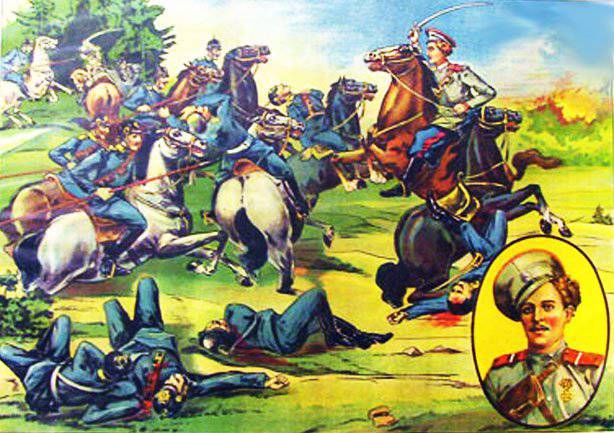
Fig. 8 Kazak Kozma Kryuchkov in battle
And the first full cavalier of St. George in the German war was a Cossack of the Miass stanitsa OKV Ivan Vasilyevich Pashnin. Being an 3 scout of the Ufa-Samara Cossack regiment, being constantly among the enemies, he obtained and transferred valuable information to the division headquarters. Commander-in-Chief of the Russian Army N.N. Romanov personally presented the hero of a thoroughbred front horse, and the fellow countrymen with the name weapon with which he had gone through all the world and civil wars, with them the acesul Pashnin and departed to emigrate to Harbin.
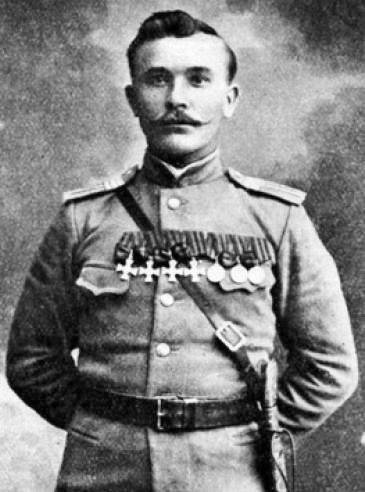
Fig. 9 Cossack Ivan Pashnin
The first award of an officer of the Russian Army with the Order of St. George 4 degree also applies to the period of battles in East Prussia. This officer was the Don Cossack, the primitive 1-th Don Cossack regiment Sergei Vladimirovich Boldyrev. Not only large Cossack formations, but also individual Cossack hundreds played a significant role in the battles. As part of the 4 th rifle "iron" brigade A.I. 35-th separate Don Cossack hundred covered himself with unfading glory of Denikin. October 12 Cossack this hundred L. Medvedev, being in intelligence, one captured the Austrians 35 and delivered to the brigade headquarters. And the senior non-commissioned officer of this one hundred Kozma Aksyonov with 10 Cossacks brought Austrian prisoners from 85 intelligence. In just a month of 2 battles, the Cossacks of this hundred captured 180 enemy soldiers, having themselves lost only 8 Cossacks. And here is an example of a massive Cossack heroism from the Battle of Galicia. The Austrians broke through the front of Brusilov's 8 Army. The commander sent the last reserve to the breakthrough — Kaledin's Cossack division (Don Cossack, the future Don Ataman) with the order: “The 12 Cavalry Division is to die, but not to die, but until evening.” The division head held on, but realizing that in the defense of the mass of the enemy he would simply be crushed, he decided that he needed to die with music. He gathered all his strength and threw Cossack lava into the oncoming enemy, personally leading the attack. The Austrians could not stand the insane mental attack and rolled back in panic.
Fig. 10 Cossack prayer before the attack
The Russian army in the 1914 year during the offensive actions had several heavy tactical defeats, which were accompanied by huge losses. Suffice it to say that by the beginning of December 1914, the shortage of Cossack units amounted to two thirds of the personnel. By the end of November, an acute shortage of weapons and especially ammunition began to be felt and the command had stopped the offensive, a lull was established at the front. And there was still a long war ahead, demanding the exertion of all the forces of the country. However, both the financial and economic situation of the country was strong, and there were no deficiencies in the means of power supply, both the army and the population were not perceived, there was no danger from this side. The military operations in the first months of the 1914 war of the year for the command of all countries served as a vivid example for assessing the nature and characteristics of the war between countries with a developed industry, the classical organization of the armed forces and having a rich material, moral and human potential. The first months of the war destroyed the false notions about the “transience” of the war, the terms of which were determined by the general headquarters of all countries in the 3-6 months. But after six months of war on the Western and Eastern fronts, not one of the warring countries not only thought to stop the war, but, on the contrary, continued to increase their armies and military, and the entire national industry adapted to service. military needs. In addition, there has been a significant revaluation of values. The ideas of the Russian and allied command about the Russian army as a “powerful shaft”, which katyatsya from the east and destroying the resistance of the Germans in its path, were completely destroyed. The power of the "shaft" at its first contact with a stubborn and persistent opponent found in itself serious gaps and shortcomings that caused the death of two corps of one army and serious consequences for the other. The losses of the Russian army in the East Prussian operation reached an unprecedented figure - 100 thousand people, including 70 thousand prisoners. 10 generals were killed, 13 captured, left to the enemy 330 guns. The resistance of the German army turned out to be more stable, and its command showed more skill in controlling the troops and using them in battle. The “invasion of Germany” on the part of Warsaw also ended for the Russian armies with the defeat of three corps and the nearly secondary destruction of the 2 Army. At the same time, the Russian troops, having no victory in Prussia, won in Galicia, killing, wounding and taking prisoner 400 000 soldiers of Austria-Hungary.
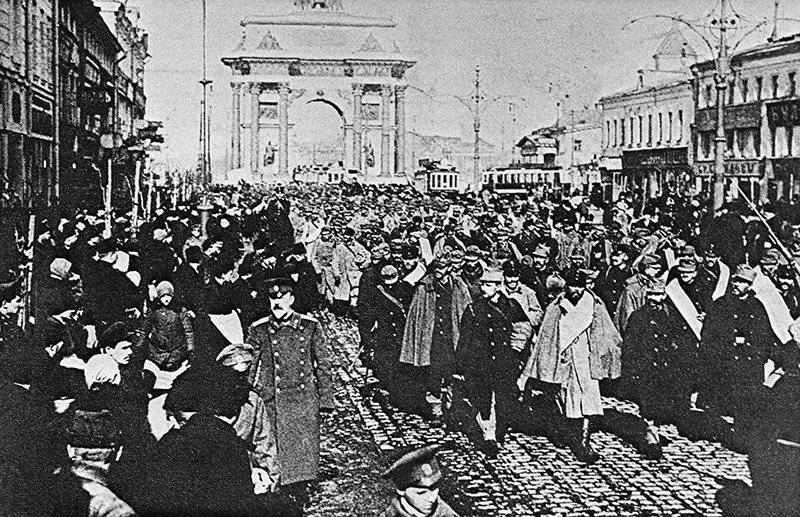
Fig. 11 Austrian prisoners are on the streets of St. Petersburg, 1914 year
During the offensive, the cavalry corps of Generals Dragomirov and Novikov were formed and were actively operating on the South-Western Front. However, many Cossack regiments successfully acted as corps cavalry, and some hundreds as attached cavalry rifle regiments and brigades. They took care of the flanks, provided communications, guard headquarters, carts, communications and conducted reconnaissance. This war again showed that the Cossack intelligence service was still unsurpassed by anyone.
In November, the Cossacks of the 2 Division of the Cossack Division captured the Uzhok pass, opening the way for the army to the Hungarian plain. The 48 Infantry Division L.G. Kornilova passed over the Carpathians, descended to the Hungarian plain and took Gumyonnoe. But her successful actions were not supported by reserves in time, and the achieved breakthrough could not be developed. As a result, the heroic 48-division with heavy losses under the cover of the Cossacks retreated back to the mountains. But in the Carpathians, the Kornilov and Cossacks sat firmly and did not give the passes.
On the Serbian front, things went wrong for the Austrians as well. Despite the great numerical superiority, they managed to occupy only 2 of December which was on the border of Belgrade, but the Serbs beat off Belgrade of 15 of December and drove the Austrians out of their territory. Despite all the difficulties, the Entente countries were able to coordinate their actions on all fronts. With the onset of cold weather fighting freezes. By the end of 1914, all fronts had stabilized, and the war entered a positional phase. A new 1915 year has come, but that's another story.
Materials used:
Gordeev A.A. - History of the Cossacks
Mamonov V.F. and others. - History of the Cossacks of the Urals. Orenburg-Chelyabinsk 1992
Shibanov N.S. - Orenburg Cossacks of the XX century
Ryzhkova N.V. - Don Cossacks in the wars of the early twentieth century-2008
Unknown tragedies of the First World War. Captives. Deserters. The refugees M., Veche, 2011
Oskin M.V. The collapse of the horse blitzkrieg. Cavalry in the First World War. M., Yauza, 2009
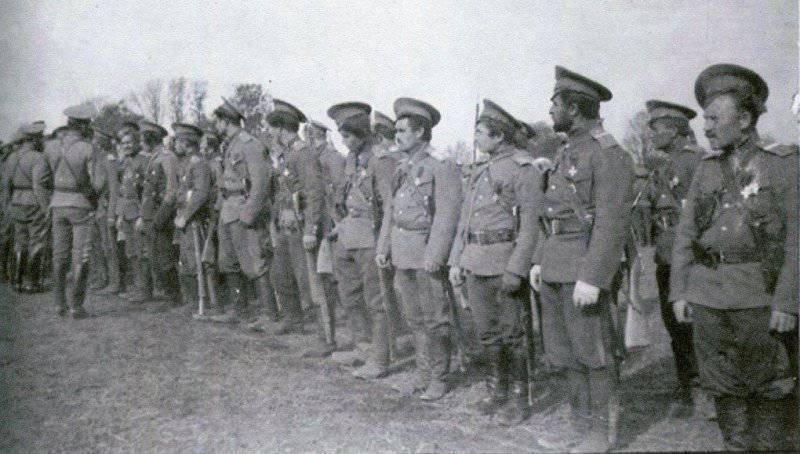
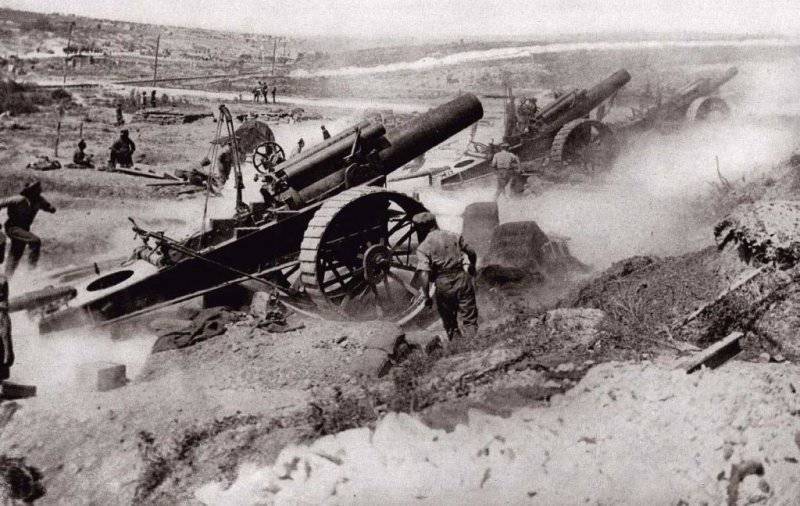
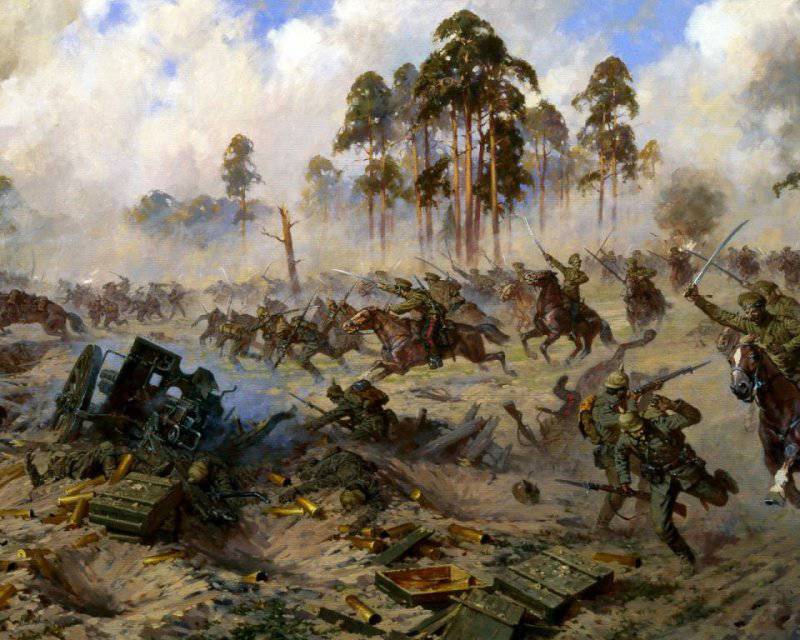
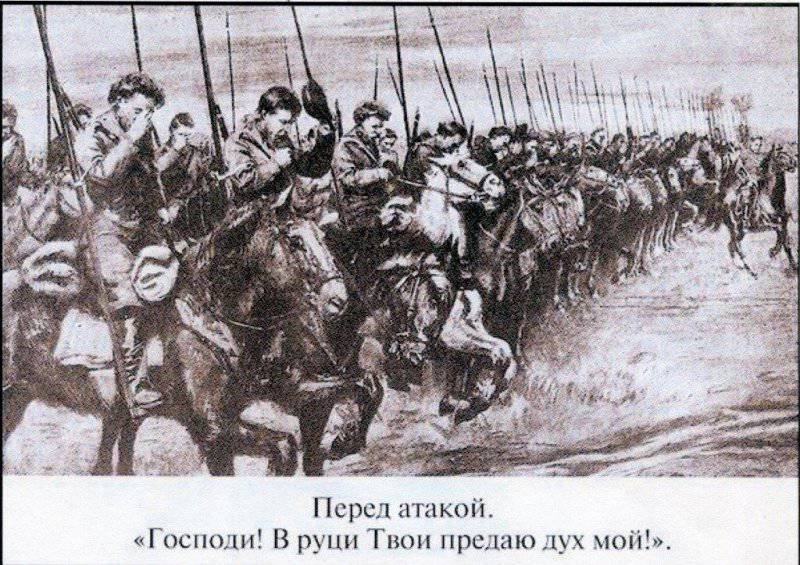
Information